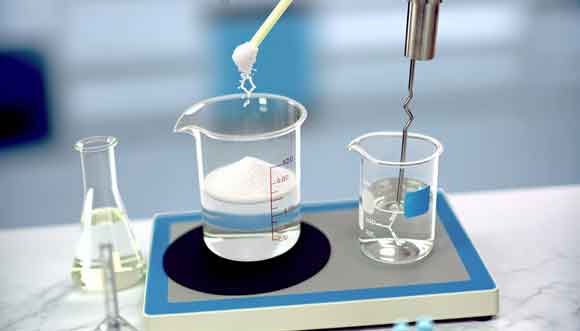How to prepare an EDTA solution
The process of preparing an EDTA solution is relatively simple, but there are some precise steps that need to be followed.

Content Tables
Materials and equipments.
- EDTA (hydrochloride or disodium salt): Select the appropriate form of EDTA, e.g. EDTA-2Na (EDTA disodium salt) is a commonly used form.
- Deionized or distilled water: for dissolving EDTA.
- Precision balance: for weighing EDTA.
- Measuring flasks or volumetric flasks: used to configure solutions.
- Stirring bar or magnetic stirrer: used to stir the solution.
- pH meter (as required): used to monitor the pH of a solution.
Configuration steps.
- Weigh EDTA accurately:
- Calculate the mass of EDTA required based on the final concentration and volume of solution
needed. For example, if 1 liter of 0.1 M EDTA solution needs to be configured, calculate the
mass:
- The molar mass of EDTA is about 372.24 g/mol.
- Mass required = 0.1 mol/L × 372.24 g/mol × 1 L = 37.224 g。
- Calculate the mass of EDTA required based on the final concentration and volume of solution
needed. For example, if 1 liter of 0.1 M EDTA solution needs to be configured, calculate the
mass:
- Dissolve the EDTA:
- Add the weighed EDTA powder to an appropriate amount of deionized water (approximately 500 mL) (final volume will be added to 1 liter).
- Continuous stirring using a stir bar or magnetic stirrer helps to dissolve the EDTA completely.
- Adjust pH (as needed):
- EDTA solutions are most effective at a pH of about 7.0. If pH adjustment is needed, use a dilute sodium hydroxide (NaOH) solution to raise the pH or dilute hydrochloric acid (HCl) to lower the pH. use a pH meter to monitor the pH and add adjustments slowly to avoid drastic changes.
- fill the volumetric flask:
- When the EDTA was completely dissolved, the solution was transferred to a 1-liter volumetric flask and fixed to a 1-liter scale using deionized water.
- Mix and store:
- Mix gently to ensure a homogeneous solution. Place the configured EDTA solution in a fully labeled storage bottle, marked with the concentration, date of configuration and purpose, and store in a cool, dry place.
Precautions.
- EDTA is a very effective chelating agent that can form stable complexes with many metal ions, and should be used with attention to metal selection and interactions.
- Configuration and use should follow laboratory safety practices and wear appropriate protective equipment such as gloves and goggles.
- If preparing higher concentration solutions, use cooling water whenever possible to minimize the heat affecting the stability of EDTA.
With the above steps, the EDTA solution can be successfully configured for use in experimental analysis and other applications.
